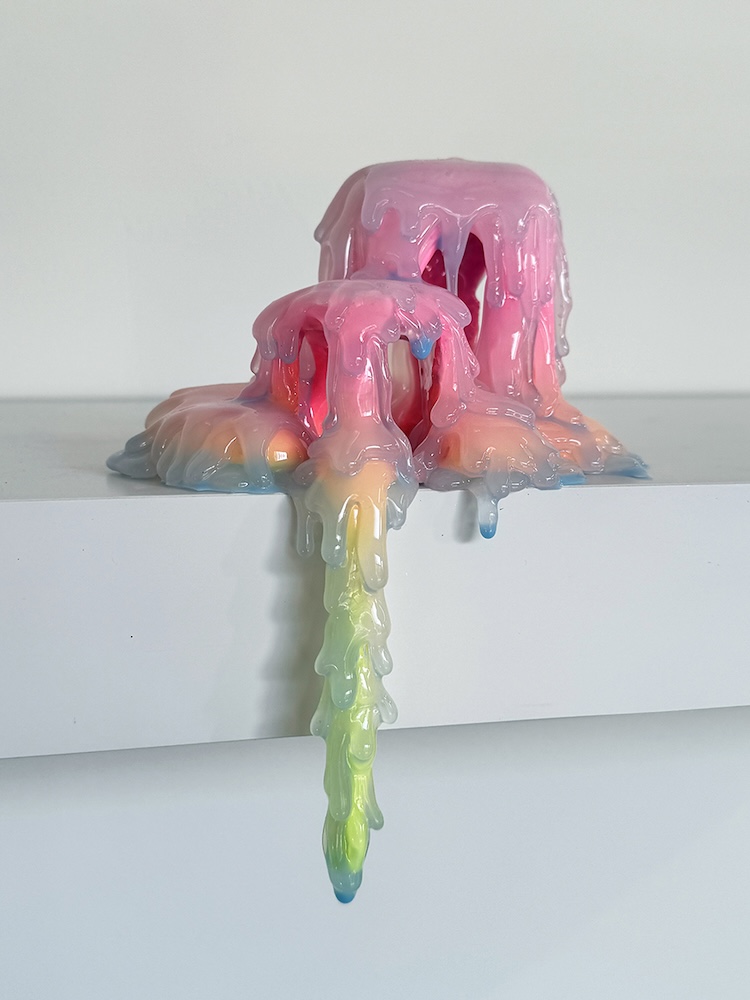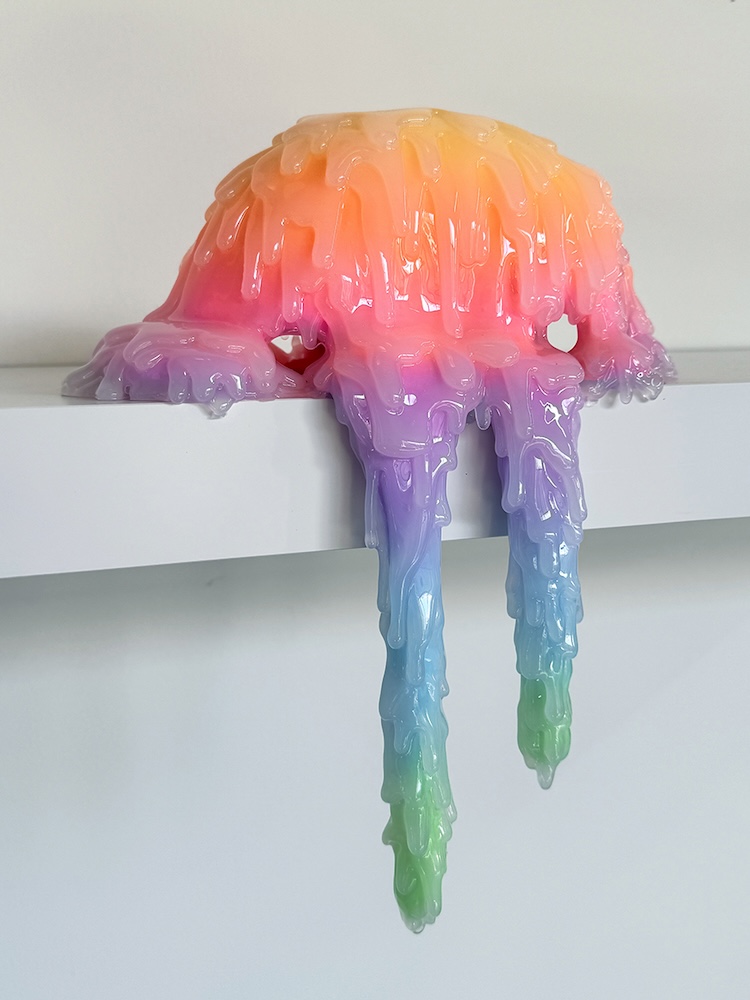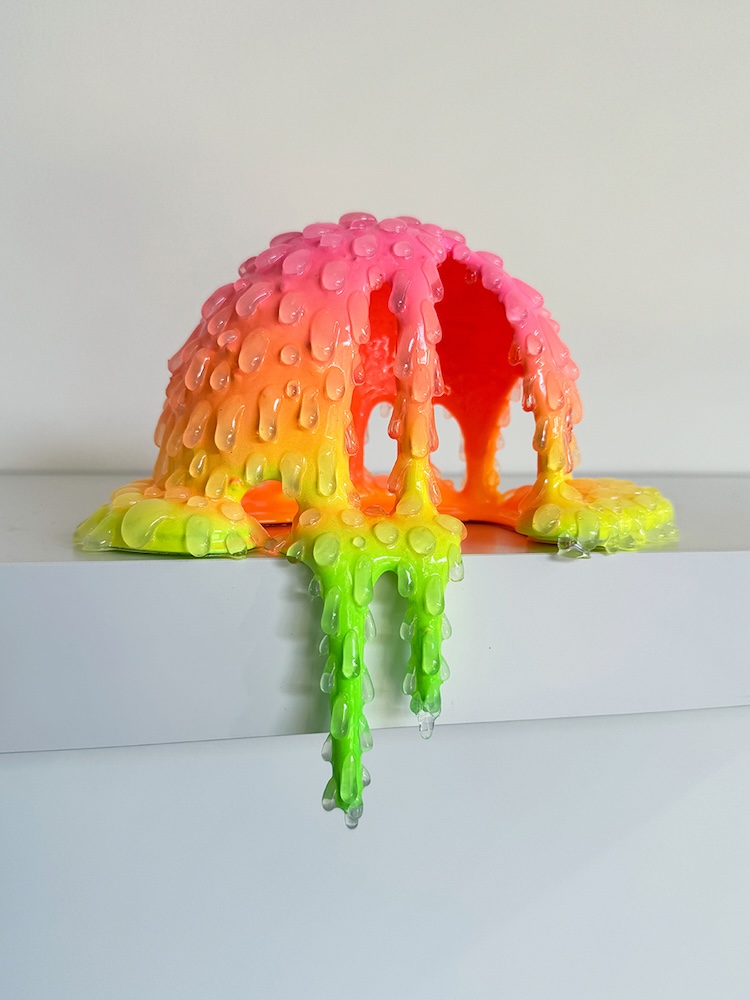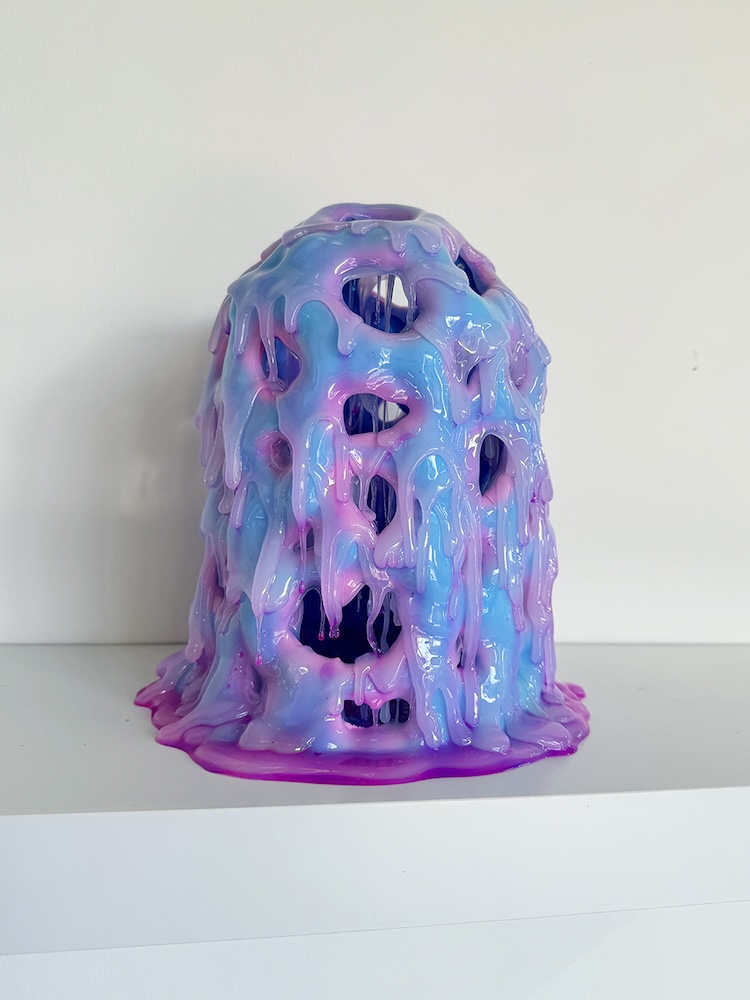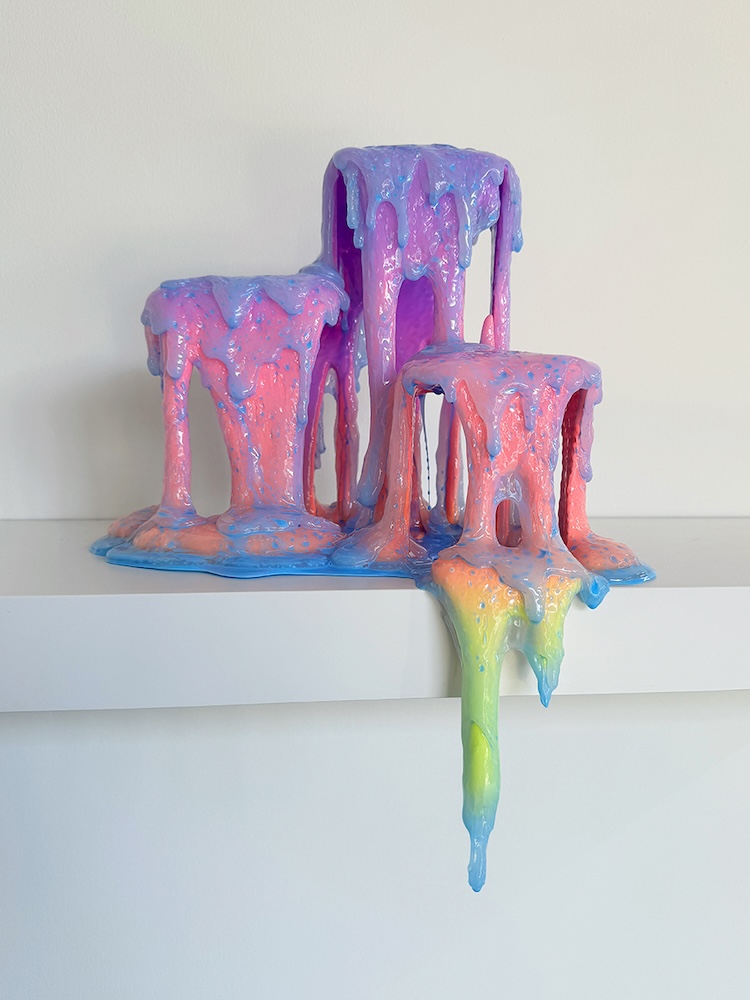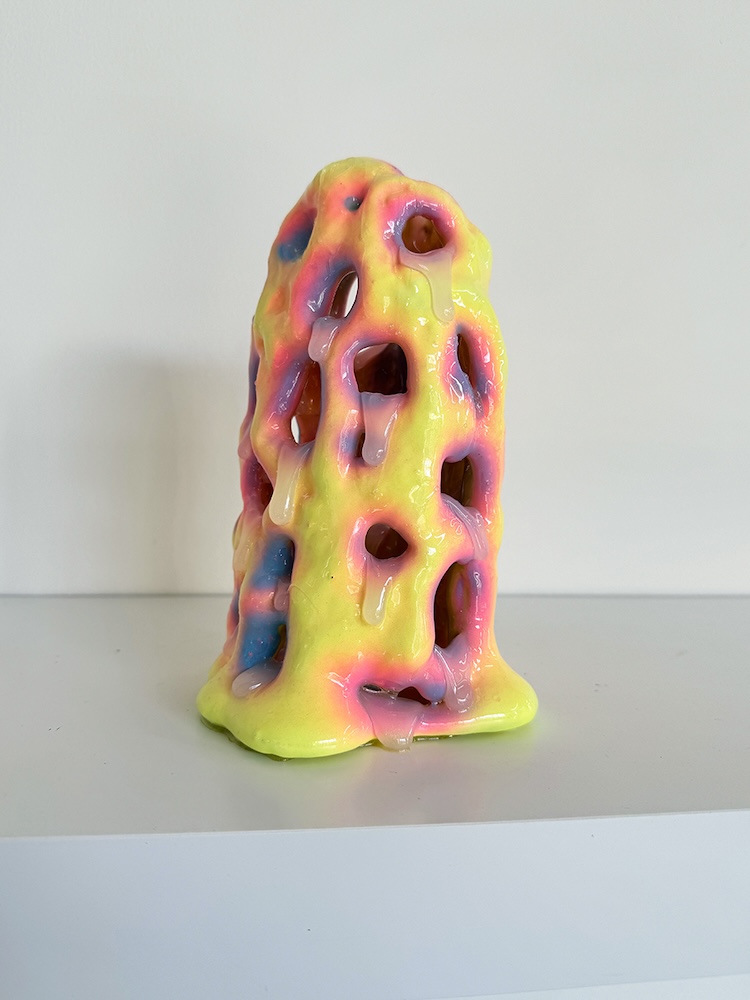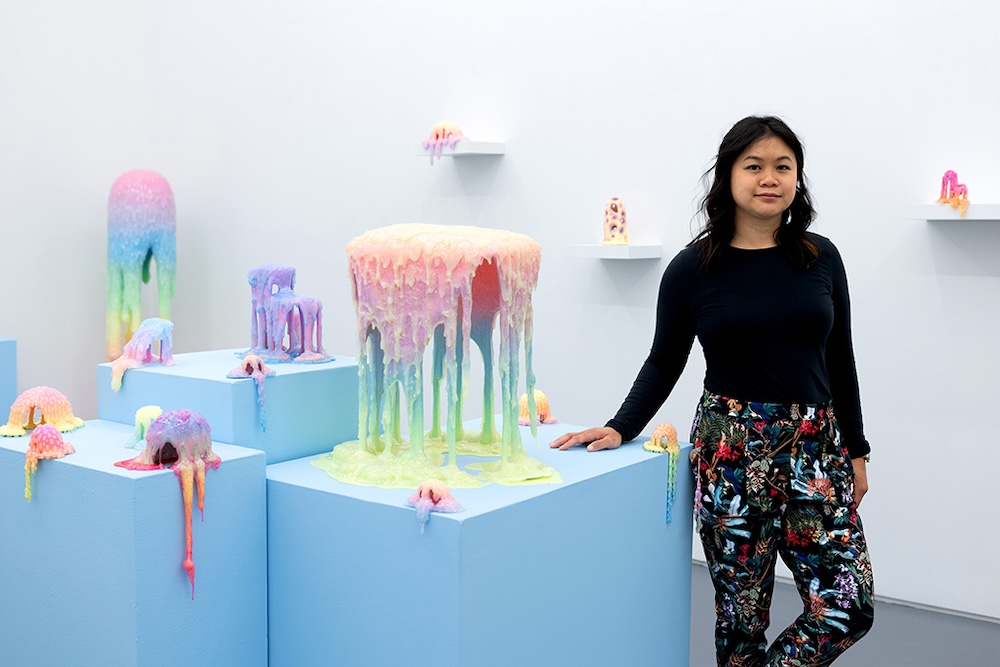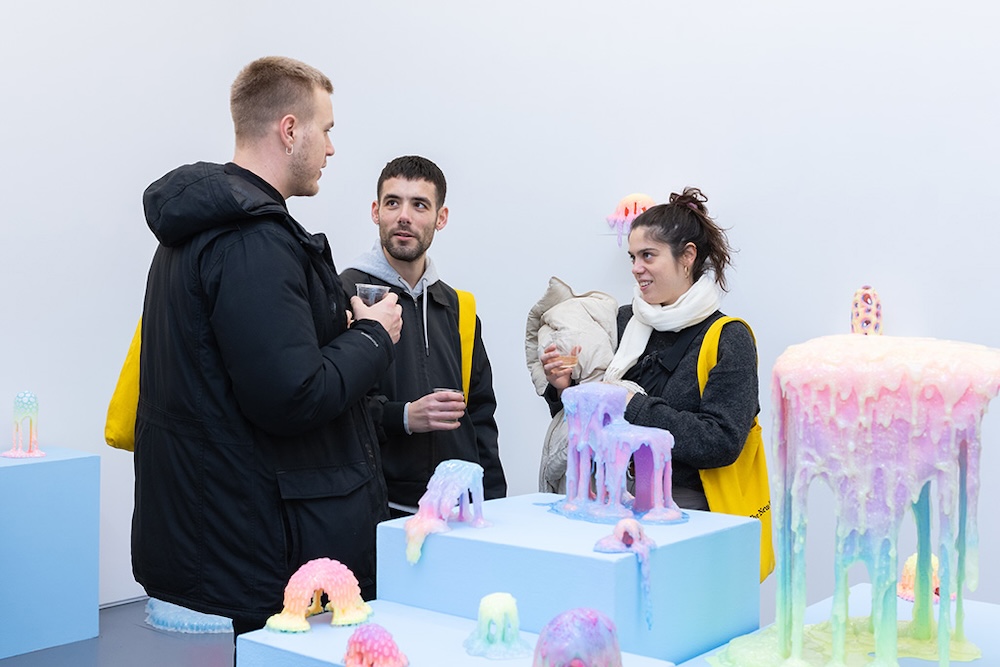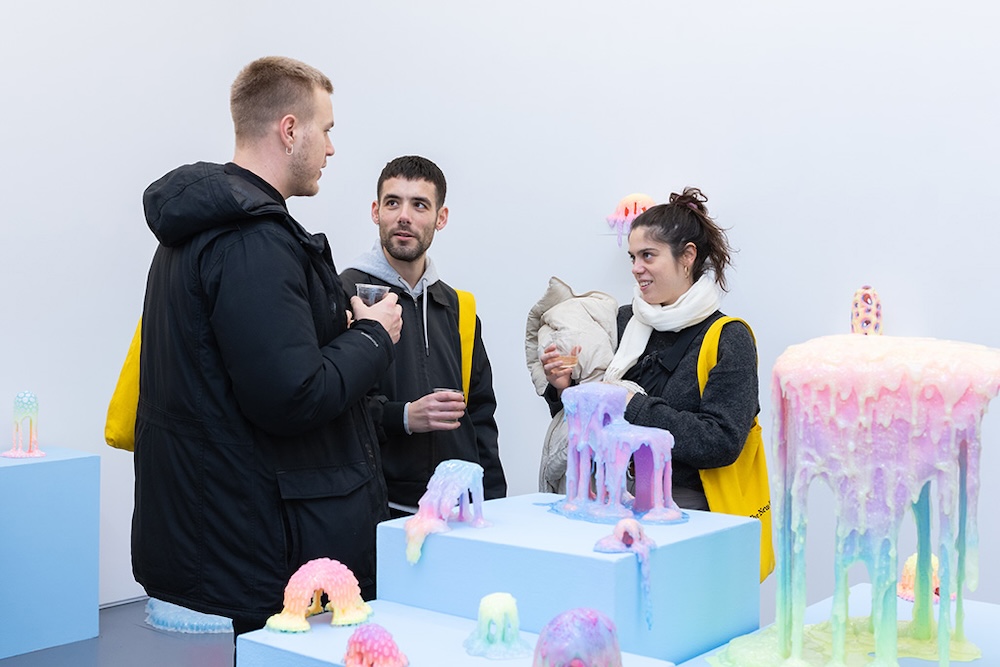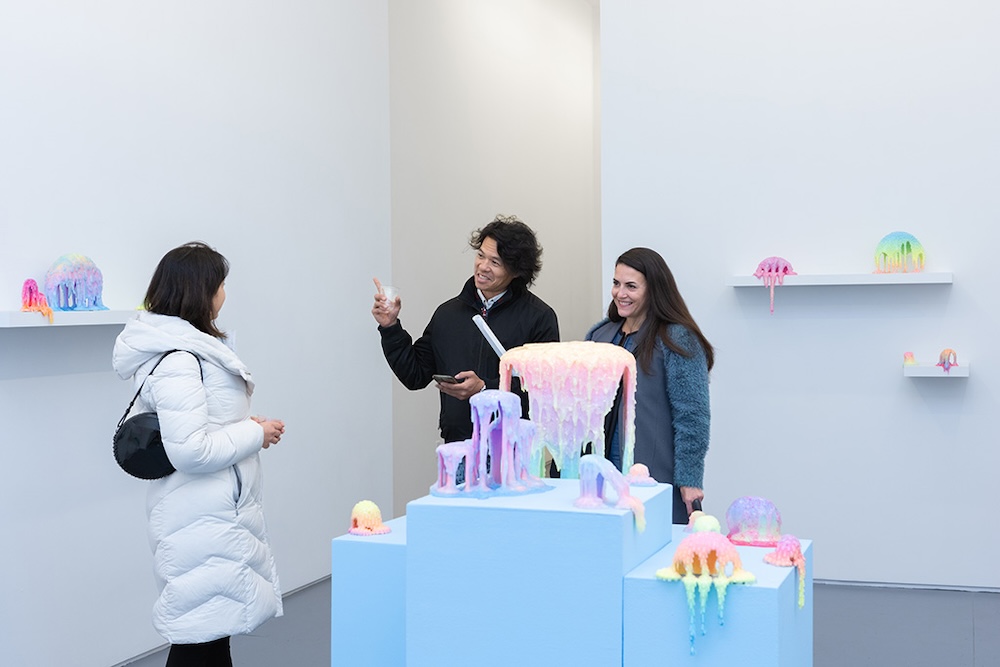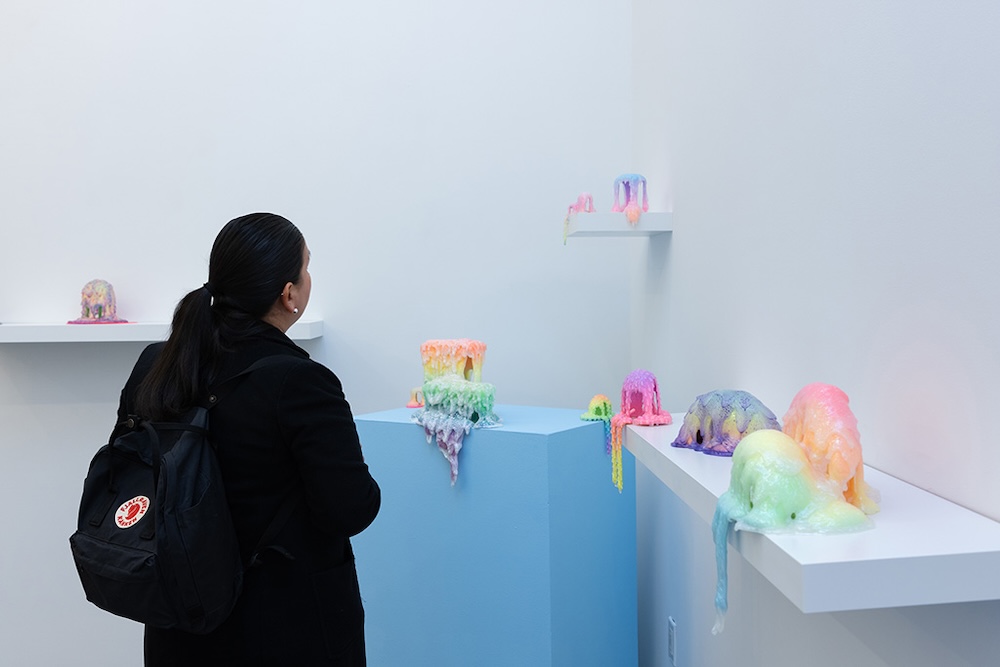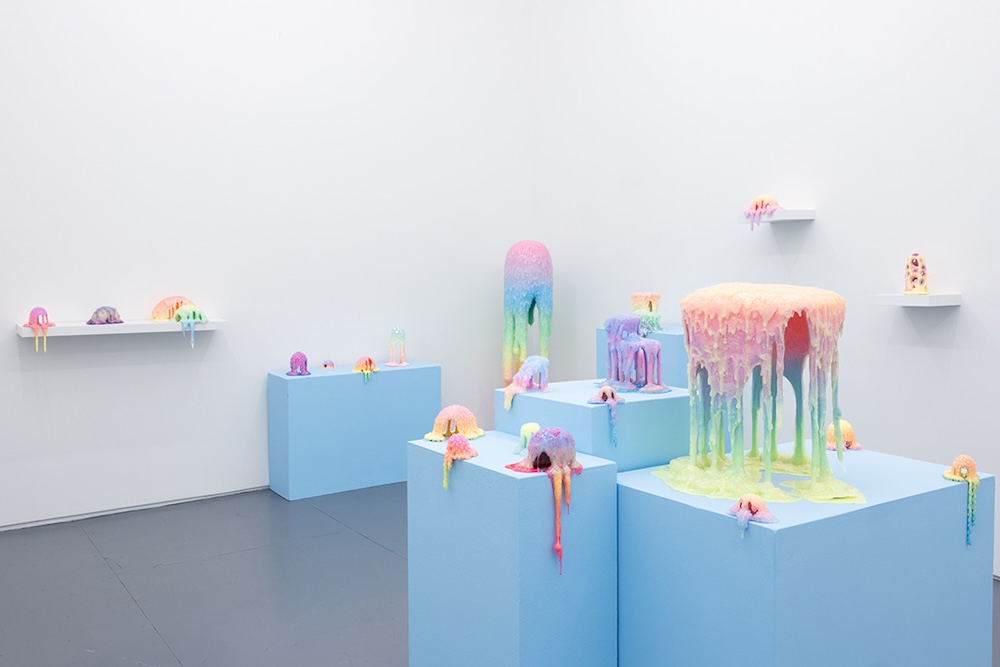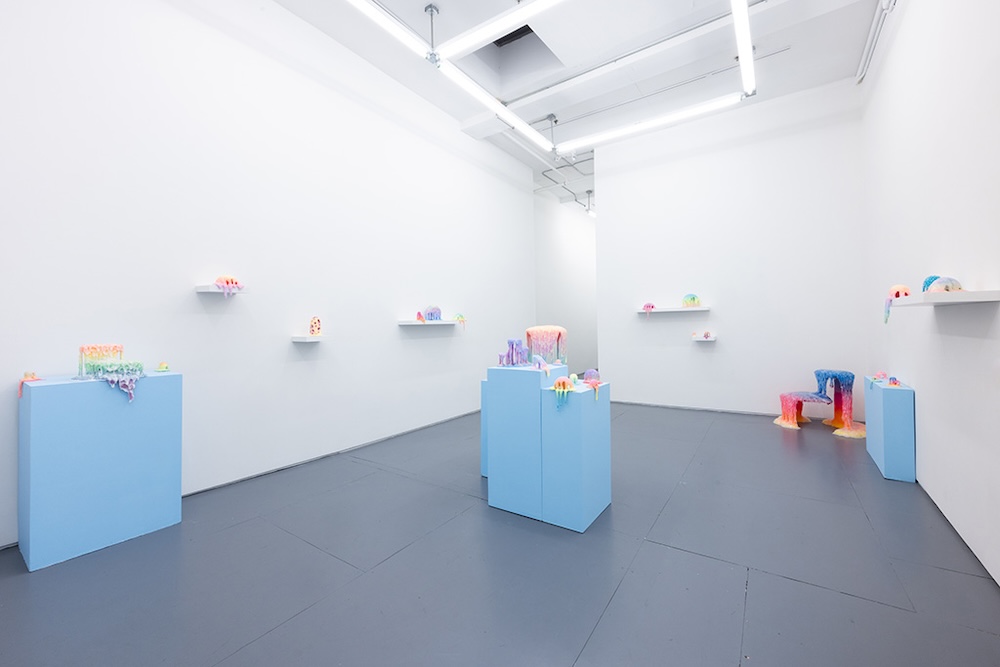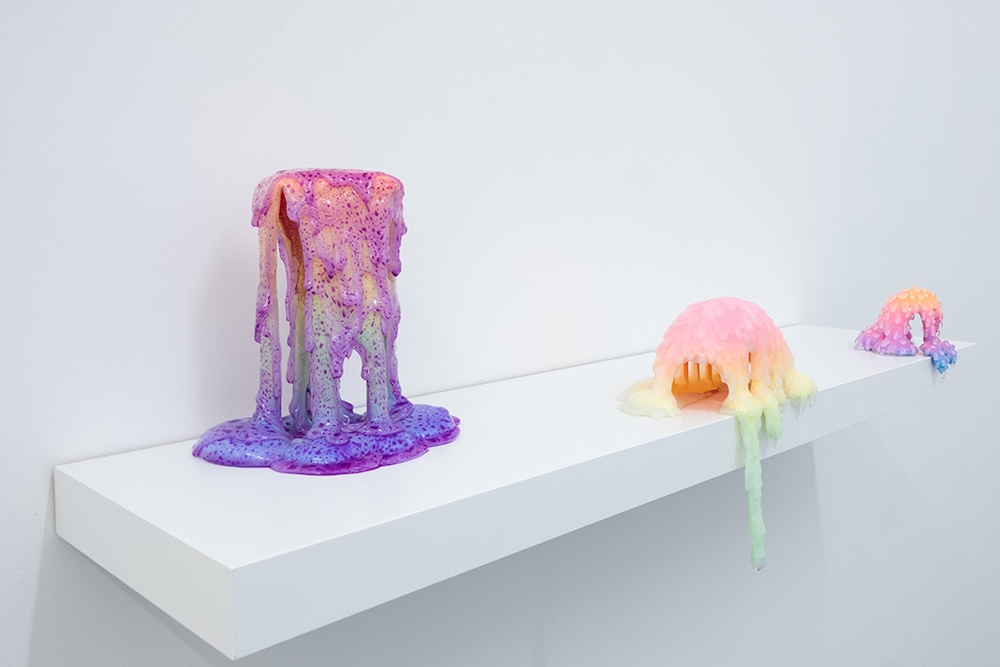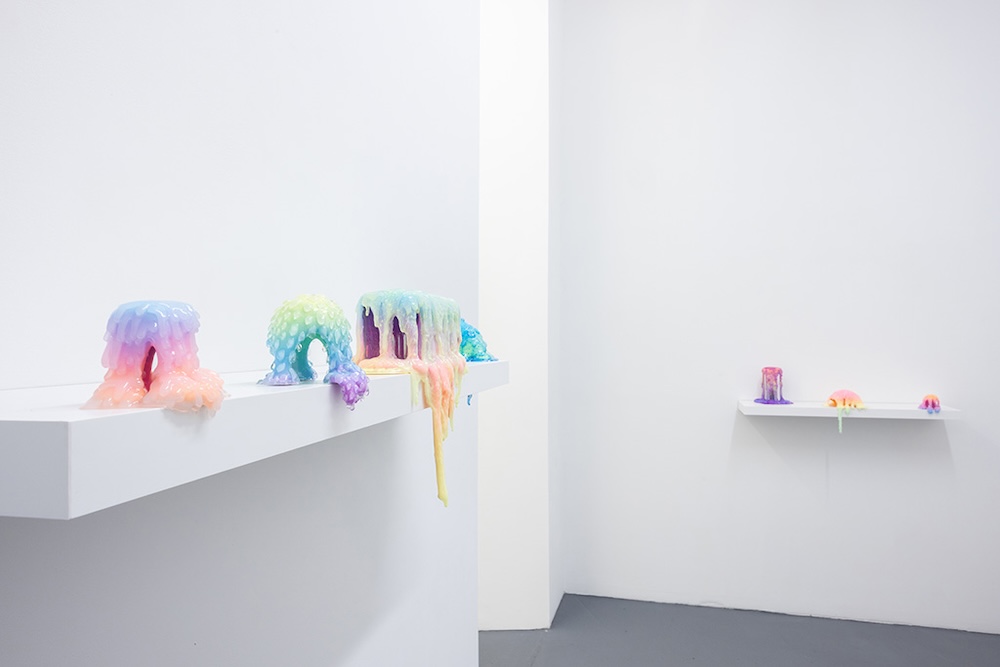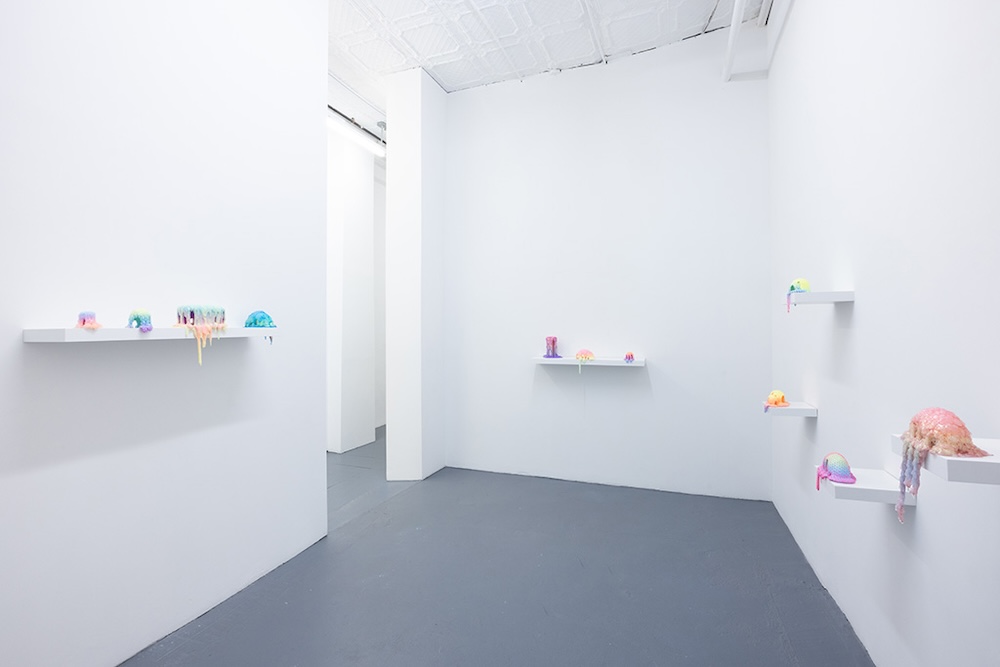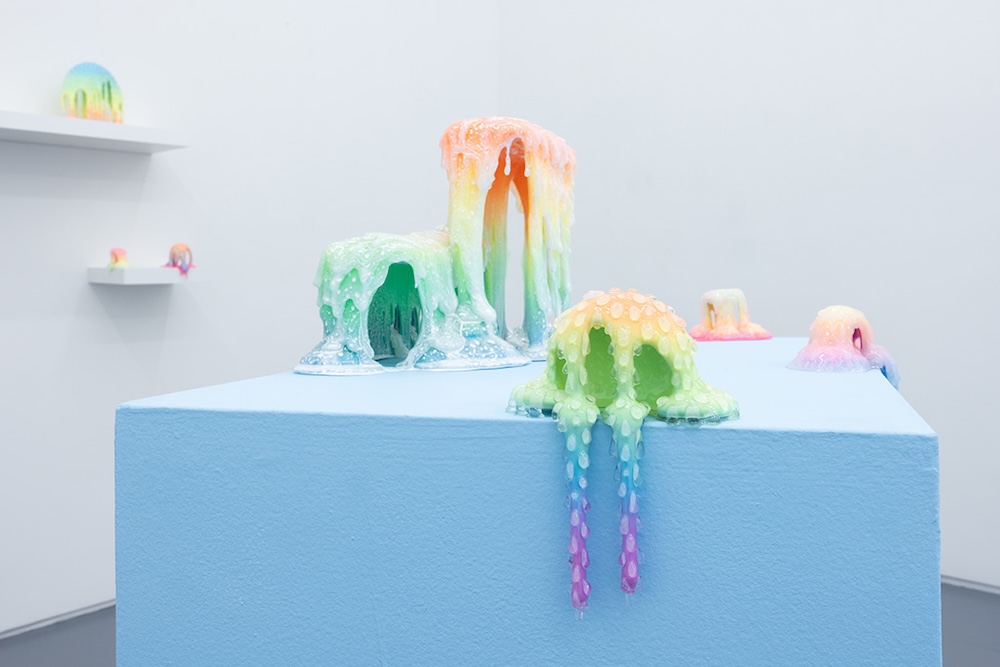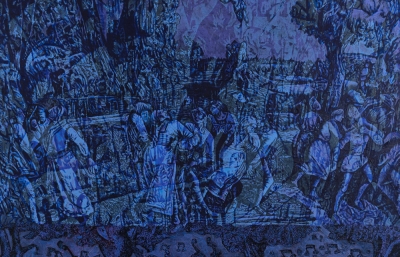Dallas-based artist Dan Lam has never been afraid to experiment. While this attitude might panic artists who prefer to exercise creative control over all details of their practice, Lam has always embraced new materials and textures into her work and new methods of pouring or applying the medium. Her solo exhibition Guttation at Hashimoto Contemporary NYC is no better example of this. Taking aesthetic and conceptual inspiration from the guttation process where plants and certain fungi expel excessive nutrients in their system, Lam revisited previous textures with a new twist, and took on a particularly frightening challenge: to make artwork that might be regarded as unappealing. Blending textures and pigmentation the artist would typically avoid, the works in Guttation reveal an ugly truth—survival isn’t always pretty.
In advance of the exhibition’s opening, Lam spoke with Hashimoto Contemporary’s Katherine Hamilton about her technical and emotional preparation for this show, showing “ugly” work, and how humans can learn a lot about our feelings from watching plants.
Katherine Hamilton: I was thinking about this interview with Juxtapoz you did before a solo show you did at Spoke Art in San Francisco in 2015. You were talking about how, at the time, you were looking at body modification in celebrity culture as an influence on the forms of your work— the voluptuousness, how your shapes are full-bodied. I’m wondering if this is still something you think about in your practice or if you’ve shifted away from it entirely. How are you now approaching the link between your sculptures and the human body?
Dan Lam: I don’t think about it directly anymore. Even in this new work, some elements still remind me of skin and fat. There’s still this bodily element to the work, but it’s not a direct reference to body modification and celebrity surgeries. Of course, because I participate in our 21st-century culture and I’m on social media, I’m up to date on pop culture stuff like that—I don’t live in a vacuum; it’s hard not to be somewhat influenced by those things. And so inevitably, those ideas about body image and modification come out in the work, but it’s not direct anymore. Now, I think more about how our human bodies and processes are part of nature.
So there’s still a connection between your sculptures and the human body, but it’s not a replication of skin or fat.
Yeah, I’m not directly addressing beauty in that direct way anymore.
Let’s talk more about things that are influencing you now. The term “guttation,” the name of your exhibition at Hashimoto Contemporary, wasn’t something I had ever heard of before researching this show! From what I understand, it’s the natural process where vascular plants excrete excess nutrients. Is that right?
Based on my research, fungi will do it as well. Sometimes, it’s just water that comes out, which I guess is a nutrient for plants. One of my hobbies is taking care of plants. I had witnessed guttation happen a couple of times with some of my cacti or succulents and then once or twice with regular houseplants. Maybe I watered them, and they didn’t need water. The leaves formed these little dewdrops on the edges like it had rained inside, though obviously it hadn’t.
To witness something in your care go through that process was pretty interesting. But the first time I encountered guttation was while I was researching fungi. There’s a particular fungus, the Bleeding Tooth or Devil’s Tooth Fungus, that releases red drops. It’s very gross. It looks like it’s bleeding. But it’s interesting, too, because the crimson, that color of red that it emits, is really rich, like rubies. If the texture doesn’t gross you out, it’s almost pretty.
KH: That’s so funny because while I was trying to understand guttation, I was looking at scientific diagrams like 8th-grade classes, and the droplets that came out were almost always clear. In these more mainstream depictions, it looks very pristine and neat, even clean. So, it’s almost jarring to encounter this gross, even ghastly, version of it on the Devil’s Tooth. So, when you saw this, were you immediately thinking, “This is something that would be interesting to explore in my practice”? Or did it take some experimentation before you landed on it as a theme?
The name “Guttation” and the process have been on my mind for a while. Whenever I do shows, I have a list of titles I want. Anytime I do a show, there’s something new thematically that I’m focusing on—a new texture or shape or whatever.
I work with a designer for promotional stuff, and he and I had a call, and I hadn’t decided on a title yet. It was down to the wire because he needed that information to make the invites. And he said, “So what names are you thinking?” And I was like, “Well, you know, I have this one: guttation.” He said it was perfect, that it fits. So I thought, okay, let’s go with it. The thing about guttation is that it’s not always pretty, especially when it comes to entities like the Devil’s Tooth. In the past few shows I’ve done over the years, I leaned more into ideas of beauty. So now, the pendulum is swinging a bit in that I’m revisiting some of these “grosser” visuals.
It’s interesting you mention a pendulum between “beautiful” and “gross,” because, when speaking about your work, people often bring up this connection between desire and disgust. And since you’re thinking less about beauty these days, I’m wondering if you’re still exploring the tension or similarities of these two things that seem like opposites.
Oh, absolutely. I haven’t left those ideas behind. In my mind, desire and disgust still belong together; they still go hand in hand. But, naturally, as I work on the artwork and it evolves, my aesthetics change and lead me elsewhere. One show might be more beautiful, and the next one leans the other way. That’s something I can see now that I’ve had years of work and shows to look back on. These ideas of attraction and repulsion are macro concepts that I work under, like an umbrella. The work always links back to it somehow.
Thinking more about your studio practice, you usually explore a different technique in the studio for each show. Is there a new technique you developed to make the works for Guttation? And if so, what forms of experimentation were you doing to get to that process?
Yeah, this show definitely has some new textures. I always leave myself room to play and experiment with the materials I work with or sometimes introduce new materials I’m curious about. I think naturally, as the work evolves, the shows become to look different and explore different topics.
The last thing I worked on before this show was this mini drop, where I revisited some of my spike textures, like a throwback. It was just something that I had never made available to people on such a large scale. And then, moving into working on the show, this throwback release I had done stirred a desire to do something relatively different from anything I had done before, moving away from familiar, recognizable forms while not discarding them altogether. I wanted to push the boundaries of what my materials can do. The things I did aren’t big leaps. But looking back on past eras I was in, with some hindsight, I can see where specific aesthetic changes happened for me.
What were some of these specific leaps, even if they were small?
Well, there are a couple of new textures that I’m playing with. One definitely embraces the gross. This “gross” texture has been an exciting thing to play with because, when I’m doing a show, I want it to be successful on multiple levels. One of those levels is sales, right? And so, making something ugly is interesting, conceptually, because the typical idea of making art is to make something beautiful. But on an audience level, can it be appreciated? Do people want to buy or live with ugly objects? Can they understand an ugly thing? But then, what is ugly is subjective. For example, I think these Devil Tooths are cool, but many people might look at it and want to vomit. So, it’s one of those weird things where I want to make these “ugly” things, but there’s a balance between the two and a decision I make in what I want to present to the public. The fact that Hashimoto lets me do what I want to do is so awesome.
What “ugly” things should audiences expect to see in Guttation?
You’ll see some more conventionally beautiful objects, and then you’ll see some that are a bit different. I’m working on one where the colors are not my usual. It’s almost brown... And I never use browns. It’s just... I don’t know, gross! The sculpture is disgusting on its own, but I think it’s almost prettier when in dialogue with another piece. There are dialogues like that between a lot of the pieces.
It seems like there are many conceptual reasons why you might start making a different texture doing that experimentation. The experiment isn’t just “What will this look like if I mix x material with y?” but one with the audience and their reaction to “ugly” work.
The very idea that somebody could make “bad” artwork is also very subjective. To say it’s “bad” means not good. But really, it just depends on who’s viewing it. It’s the same with ugly. As an artist used to making beautiful things, it’s challenging to present something that is potentially ugly. It pushed me out of my comfort zone a little bit. Even though I have made ugly things in the past, every time I do it or make something intentionally ugly, I always wonder if it’s “too” ugly. Making something “ugly” brings a weird personal discomfort.
I want to return to the question of materials in your experimentation. In doing some scientific research for this show, I was surprised to learn that many of the materials you use that are perceived as “synthetic” actually have naturally occurring counterparts. For example, I hadn’t known that resin occurred naturally, like in amber. I think there’s a relationship between the materials you use and how you mimic the process of nature in the studio, even if resin, polyurethane, and those materials are perceived as artificial or inorganic. Do you feel like there’s a tension between the materials you use and the concepts of nature you’re interested in? Or is it more of an expansion of where those two things overlap?
I think it’s both things. My interest in the materials definitely reflects the times we’re in. If I didn’t live or make art in this period, those materials wouldn’t exist in my work. And so using resin and polyurethane, they’re like timestamps of now. At the same time, I’m super drawn to nature. Melding these two things together is the big question. Natural processes inspire my work, and then I use those natural processes with synthetic or unnatural materials to create a natural process within the studio. I think there is a tension between these seemingly organic objects being made with completely inorganic materials. There’s some kind of statement there, but it’s not one that I’m stating.
The conversation right now, around that unstated statement, is about environmental concerns. It’s something that we all have to think about and deal with. I use these “artificial” materials in my practice as a celebration of these materials and nature. I’m using unnatural materials, but who’s done it better than nature? My work celebrates nature’s capacities in the ways it can, which happens to be with these “unnatural” materials. But there’s something about how we humans have synthesized these materials too that could be... it’s not natural, but it is a process. We’ve taken things from nature and made them do something they couldn’t have done without us. If I were just using natural materials... why would I do that? We’ve seen what I’m emulating because nature’s already done it. I’m doing the things that nature hasn’t been able to do.
I liked what you said about the cycle between your work and nature: you’re referring to natural processes and using “inorganic” materials to recreate an actual process. But you’re also an expert on that by now, so I’m wondering how you find new ways to be experimental in the studio. How do you find a different way of leaving things up to chance or imbuing some chaos into your process?
And after months or years of honing in on one thing, you become proficient at it. Your process is a skill that you acquire and practice. It feels like what I’m saying relates back to your question about developing something new for the show or every show I do. I like to do a couple of things to give myself a challenge. I might introduce a new material, meaning I bring something new that I haven’t worked with before, which stirs the pot because I’m learning how that material reacts to my actions and other materials I use. It stirs the pot; I’m learning something new. And then, from there, I try to figure out how I can push this material. What can I do with it that’s different or gives it a different spin?
Do you have an example?
Let’s say I take polyurethane foam—I use it a lot, and I know how to control it. As an experiment, what happens if I pour some acetone on it? I don’t suggest doing that specifically because there’s some bad chemical stuff going on there. But the idea is to find out, through trial and error, what happens when you introduce something new to the process. All of a sudden, this freshness leads you somewhere. Sometimes, the experiment just fails—you do it, but it wasn’t the right thing to do. But generally, that’s how I keep things fresh.
There are things I want to make happen or want to do, but because a lot of the materials I’m interested in are maybe more industrial or aren’t used primarily for artists, they’re not as easy to obtain. I can’t realize everything I want to realize as easily as artists who use more accessible mediums can. For example, I’m curious about the physical thermoformers where you can create giant molds of something with plastic. It vacuum seals to the shape of something to make a new, different thing out of plastic. When I discovered the technology, I was like, “Oh my gosh, what kind of things could I make happen with that!” But I can’t buy a $10,000 machine just for an experiment. So, these things interest me and are in the back of my mind that I can take a baby step towards for the next show. But in a more realistic day-to-day, I usually experiment by throwing in an unknown element to a process I’m already familiar with.
Speaking of limitations, I wanted to talk a bit about size. You just opened a big collaboration with Meow Wolf, where you presented these huge drip walls. It reminded me of organic architects who were inspired by all the harmony and contradiction in nature: Mexican organic architect Javier Senosiain and German architect Udo Heimermann and his mushroom-like designs. Is scale something you’re considering more these days?
When I think about the art I make, I think about the art I like to look at. And I want to create for others what the art I look at has done for me. Growing up, I had an affinity for unusually large objects. Do you know how people love miniature things? I love giant things. Like, I love James Terrell—he’s untouchable. He’s out there in the ether like an art God. But the experience I get from looking at his work... maybe I can do that for somebody else, albeit on a smaller scale. Or, I love Claes Oldenburg. Spoonbridge and Cherry in the Minneapolis Sculpture Garden is a landscape-changing sculpture. It’s huge, you can see it from a distance. Those sculptures are a part of how people recognize that area. And so, knowing that that’s the kind of work I like and that it evokes a type of feeling for me, I want to make larger work because I want to produce that feeling for others. And I think I’m taking the right steps towards that.
Would you ever consider trying to design a house?
Absolutely, yes, I would love to. There’s an artist named Erwin Wurm. He made this house called “Fat House.” It’s so cool. It’s just like this fat, fluffy, gross, cute house. He also did that with a Porsche—it might be called “Fat Porsche.” When I was younger, I saw “Fat House,” and I thought it was such a cool concept to break all these lines of architecture. Just get rid of the linear qualities of architecture and make it completely organic—round with no hard edges. One of my goals is to make a really large sculpture that is integrated into architecture somehow, like how Oldenburg’s Spoonbridge is part of a landscape.
We’re manifesting Dan Lam House 2030. It’s interesting that you bring up “Fat House” because it sort of feels like we’re looping back to the beginning of the conversation—being inspired by something that looks fleshy, bodily. I think “fat” is also aligned with “excess” in our culture, and “guttation” might be seen as a purging process. As I’ve looked at your work over the past few weeks, I’ve been thinking about overindulgence, too much of a good thing, and the possibility of getting rid of that excess, cleansing or purging it out, and coming out anew. I’m not so sure this is relevant, but I wanted to think with you about what it means to get something out.
I think excess has always been a part of my practice. I wouldn’t call myself a maximalist, but that’s what I tend towards—over the top. If I have a space, I’m going to fill it. If I have a bookshelf, it’s full; my house is full of stuff. My relationship with excess is... well, it’s not quite a battle, but I think about my own consumption and where to stop. In media, in my practice, how much is too much? Where do I stop? This idea of excess and purging that happens in the plants during guttation, there is a correlation between what I’m going through internally and how it comes out in the work. Whatever happens in your life tends to come out in the artwork, even if it wasn’t intended. I’ve always been interested in guttation, but it felt especially relevant now because I’ve been going to therapy, where emotional things are being brought up. Internal stuff that hasn’t been thought about or surfaced in a long time starts to bubble to the top. That just ends up coming out in the work—it comes, but then I release it and let it go because I don’t need it anymore.
You’re guttating, in a way.
Yeah, so many lessons and themes that apply to life come up as I’m working in the studio. If, as I’m working, I mess up or fail at something, it’s no big deal. I just learned something from that. That same concept applies to when I’m living my life. If there’s an argument that I have with somebody, you know, and I feel like I fucked up, that’s okay because I can learn from it and be better next time. So there’s just a lot of overlap with my life, art, and practice. Sometimes, I don’t realize it until I have hindsight, until the work is out, and then I look back on it. We were talking about timestamps earlier—that’s a timestamp of my personal journey. Excess and purging are all there. They aren’t necessarily what my work is about—I’m not talking about therapy or mental health—but I’m getting it out in the work. It’s all there.
Guttation is on view at Hashimoto Contemporary NYC through January 6th, 2024. All installation photos by Heather Quercio.

